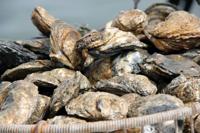BOZMAN, Md. - Bunky Chance's skipjack, Faith, looks a little rough at the moment, but maybe not as rough as this year's oyster season, which is now wrapping up.
"Overall it's it's been a challenging year, but a worthwhile year," Chance said.
Chance says oyster numbers were down this year. Prices, at $45 a bushel, were too. Wintery weather, stopping some people from oystering all together, didn't help much either.
"In the end it worked out. It all worked out," Chance said.
But watermen, like Chance, say one more thing's on their plate. More and more fisheries are now becoming sanctuaries, giving watermen less space to oyster in overall.
"These sanctuaries will actually give back to the fisheries," Matthew Gray, an oyster restoration scientist from Horn Point Laboratory, said.
Scientists like Gray say oyster sanctuaries are needed, helping to keep the Chesapeake Bay clean, other animals alive, and watermen in business.
"Doing this restoration effort, the resources are not only here for the watermen that are here currently but also for future generations," Gray said.
Chance disagrees. He says harvesting and selling oysters and then putting clean shell back can be just as effective as sanctuaries - maybe even more, helping save the Bay and save watermen some business.
"It's a proven, successful blueprint. It's a business model that's proven itself," Chance said.
Last week, Governor Larry Hogan dedicated $750,000 to the Shell and Seed Program. Rob Newberry of the Delmarva Fisheries Association says that's the largest amount he's seen -allowing watermen to put 100 million oysters back into the Bay. Newberry says that will in turn give roughly $15 million back to fisheries.





